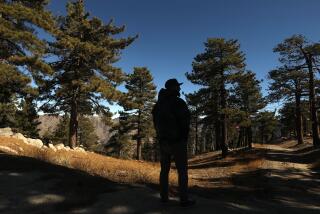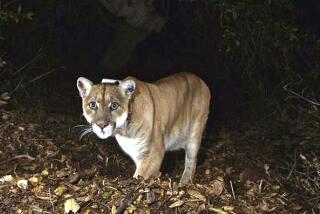La Follette Worries That Tourism Effort May Delay Improvements at Wildlife Refuge : Plan for Waystation ‘Spinoff’ Stirs Call for Inquiry
- Share via
An assemblywoman who sponsored a $300,000 grant for improvements at the Wildlife Waystation in Little Tujunga Canyon has called for an investigation into whether plans to turn surrounding property into a $2.5-million tourist attraction have delayed the improvements.
Assemblywoman Marian W. La Follette (R-Northridge) lobbied heavily more than two years ago for the grant over objections that the improvements might enhance the property’s value.
“This is very shocking to me. I have never heard anything about this,” La Follette said Thursday as she learned of plans for a tourist complex on property owned by the Waystation’s director in Angeles National Forest.
La Follette took up the Waystation’s cause in 1985, sponsoring a bill to appropriate $300,000 to bring the facility into compliance with fire and building codes so the tax-exempt charity could continue holding fund-raising activities on its property.
Fund-Raisers Popular
Drawing up to 10,000 people at a time, the Waystation’s fund-raisers had been popular until county officials threatened to crack down because of potential health and fire hazards.
The Waystation, founded in 1977, is now home for 800 to 900 big cats, bears, coyotes, wolves, monkeys and rare breeds of deer until permanent spots can be found for them--usually in licensed zoos.
The grant was earmarked for basic improvements to the water supply, power lines, fencing, sewers, drainage system and half-a-mile-long road leading to the animal preserve.
However, the cost of improvements, originally expected to get under way in the fall of 1985, has risen to at least $500,000, La Follette said.
“I’m going to contact the Department of Fish and Game and ask for an inquiry to see whether there has been any stalling in putting this project together,” La Follette said. The state department is administering the grant.
A Westlake engineer hired with some of the grant money has developed blueprints that use the improvements as “a building block” for a surrounding complex that would include a 10,000-seat amphitheater, “a mountain man retreat,” a mock Western village, a restaurant, horse trails and parking for 3,000 cars.
‘Dream’ of Colette
The tourist attractions would occupy 140 acres owned by the director and founder of the Wildlife Waystation, Martine Colette. The land surrounds the 20-acre wild animal refuge, which is owned by the Waystation tax-exempt charity, said Colette’s attorney, Byron Countryman.
Countryman, who is also a member of the refuge’s board of directors, confirmed that the plans were “a dream of Martine’s--to have them sometime in the future with the hopes that the spinoffs could somehow benefit the Wildlife Waystation.”
L. Peter Petrovsky, the engineer hired to develop the plans for the improvements, blamed the delay on coordinating the publicly funded improvements with the larger project on Colette’s land. He estimated the cost of the attractions at about $2.5 million and said they would be financed with private donations yet to be received.
“To develop a plan of such magnitude takes time,” he said.
Petrovsky said his intention in linking the two projects was to provide long-term savings for Colette and the Waystation.
“Whatever money she spends now will be a building block for this bigger project,” he said in an interview two weeks ago. “Whatever we’re building will be planned so that we don’t have to redo it later.”
6 Quaint Storefronts
He said his firm plans to submit a grading plan that will prepare the land for the tourist complex or other uses to county authorities for approval within the next six weeks to two months.
The Western village would be “something like what you are going to find at Knott’s Berry Farm,” Petrovsky said. Sketches developed by his firm depict six quaint storefronts that would serve as boutiques.
He compared the mountain man retreat to a bed-and-breakfast inn, and described the open amphitheater as similar to ones in Greece and Rome.
“In addition to the wildlife preserve, Martine is trying to build a more visible facility,” Petrovsky said. “It’s not just an amusement park; it will support the Waystation.”
Petrovsky said the plans went through three versions. He and Colette had discussed adding a hotel near the restaurant, noting that old Western saloons had rooms for rent.
“At one time, we were thinking of putting in a horse track, but I don’t know if that’s even a consideration anymore,” he said.
Petrovsky said he does not know when the upgrading of water, sewer, road and other facilities funded by the grant will be complete. But he said it will take one to two months to finish them once they get under way.
“We haven’t even developed a plan for the essentials that the county’s asking for, but it’s really minor in terms of what we’re planning,” Petrovsky said. “You don’t want to start working in haste.”
In a financial review of the organization in January, a Department of Fish and Game auditor found that the Waystation had already paid $1,500 more in engineering fees than the $7,000 allotted under the grant, said Peter Skaia, the department’s chief auditor.
The grant does provide funding for development of such grading maps, site plans and a master plan for the Waystation. And county officials said they demanded those plans for Colette’s property as well as that of the Waystation.
However, fish and game officials and La Follette said they understood that the grant was to cover just the Waystation’s land and only a small part of Colette’s land used for access to the animal compound.
La Follette said that holding up basic improvements for ambitious plans to create the tourist attractions could reflect an improper use of the grant.
“If there is a delay because of this, then I’m totally opposed,” La Follette said.
Meanwhile, an assemblyman who voted against the grant in 1985 because the improvements might enhance the value of Colette’s property questioned the propriety of the plans.
“It sounds like some of my initial concerns may have been legitimate,” said Assemblyman Rusty Areias (D-Los Banos).
The existence of the blueprints “raises the question of why the station needed $300,000 in public funds in the first place if it has some means of financing a $2.5-million amusement park,” Areias said.
Colette blames the delay in getting the improvements started on red tape, pointing out that her organization didn’t get the money from the state until November, 1986. For the Waystation to get the money, Colette had to comply with a requirement to turn over the 20 acres to the state if the site were ever used for profit.
Countryman defended the spending of public money to develop plans for his client’s private property because some of the improvements would be on Colette’s land.
Colette at first acknowledged familiarity with the blueprints, saying that they had been drafted to meet county requirements that call for a master plan.
Later, however, she denied knowledge of the plans, saying that she had never seen blueprints for the complex.
“There are no blueprints for a restaurant, hotel, motels or anything else,” Colette said. “We barely have enough funds as it is.”
La Follette said that news of plans for a tourist complex could pose “a serious handicap” to fund-raising efforts “because a lot of people who have supported the Wildlife Waystation would feel like they’ve been misled.”
Meanwhile, the Waystation appears to be in no better financial shape than when lawmakers rallied to its aid in July, 1985, with the hope that fund-raisers would be able to resume that fall.
The expense of holding fund-raisers at rented facilities has reduced profits by about 50%, said Ken Kingsbury, the refuge’s vice president in charge of accounting.
On-site fund-raisers probably will not be able to resume until October, 1988--three years later than originally thought, Colette said.
A 2,500-gallon truck still provides most of the Waystation’s water. Power feeds into the mountain outpost via uninspected electrical lines. There is no retaining wall to protect the exotic-animal hospital--which the Waystation bills as the only of its kind--from floods. Water drains from animal cages onto dirt trails.
While officials await the probe called for by La Follette, animal and conservation groups have raised questions about the implications of developing a tourist complex.
An official from the Elsa Wild Animal Appeal, a Studio City-based organization that promotes conservation of wild animals and wild places, said such a tourist complex would appear to exploit the animals.
“I would deplore the thought of their commercializing it to that extent,” said the group’s general manager, Peter Rasmussen. “If you have people trekking through there, then it’s impossible to maintain the kind of wild situation that these animals require.”
A Sierra Club official also objected to the plans because the area is zoned for agricultural uses.
“We would never support a development like that in the middle of a national forest,” said Fred Hoeptner, chairman of the organization’s Angeles National Forest Committee.
But a volunteer at the Waystation greeted the plans for a restaurant with enthusiasm.
“People don’t realize how hard it is to serve a cold drink out there in the summer and, in the winter, when we serve coffee, we have to plug it into the hospital,” said Helga Tschaeche of San Fernando.
Tschaeche, who in the past has been chairman of merchandising efforts for the Waystation, also said she “would love to have a gift shop out there.”
But John Schwarze, a Los Angeles County zoning administrator who helped with the original agreement for improvements, doubted that the development would ever take place.
Schwarze said the county probably would not allow the construction described in the blueprints because of the area’s agricultural zoning.
“They won’t get building permits for those unless they get zoning permits, and they won’t ever get those,” he said. “It’s not zoned commercial up that canyon.”
More to Read
Sign up for Essential California
The most important California stories and recommendations in your inbox every morning.
You may occasionally receive promotional content from the Los Angeles Times.










